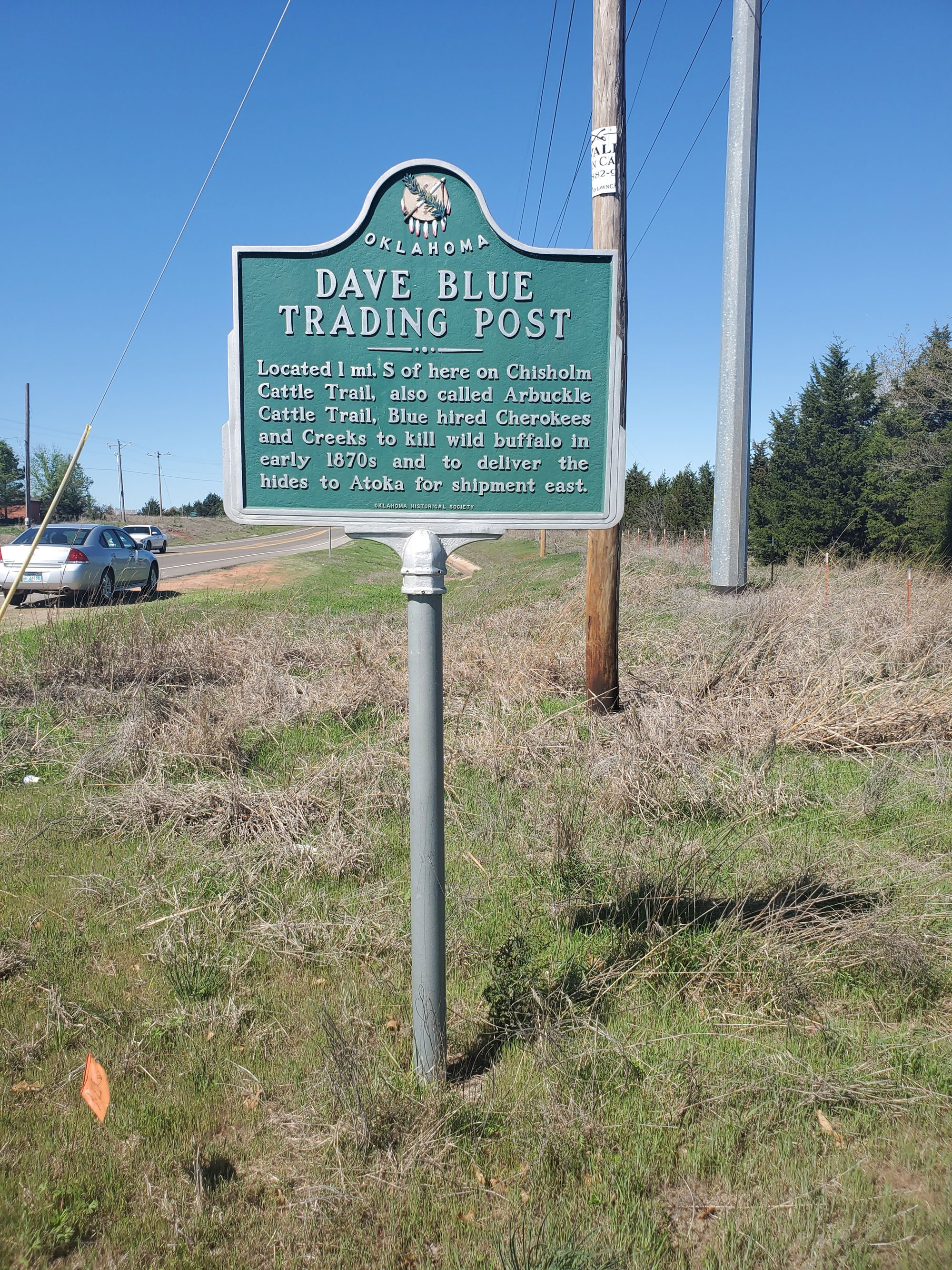
Historical Marker Program
Search Results
Your search returned 9 results.
The City of Norman and the Cleveland County Historical Museum
Cleveland CountyTopics: Family/Household; Land Openings; Settlement Patterns; Territorial Period, 1861–1907
Constructed in 1895, six years after the 1889 Run, this house, known as the Harry Lindsey Home, has been restored as a classic example of pre-statehood architecture.
Dave Blue Trading Post
Cleveland CountyLocation: at intersection of 48th Avenue Southeast and East Imhoff Road (OK-9) in Norman
Coordinates: 35.189750, -97.370517
Material: Aluminum
Sponsor(s): Oklahoma Historical Society
Topics: American Indians; Indian and Frontier Trade
Dave Blue was a trader in the 1870s who hired Cherokee and Creeks to kill wild buffalo. Blue shipped the hides to Atoka for transportation to market in the eastern United States. Blue's trading post was built along the Arbuckle Cattle Trail.

The Jacobson House
Cleveland CountyLocation: 609 Chautauqua, Norman
Material: Aluminum
Sponsor(s): The Jacobson Foundation
Topics: American Indians; Arts; Early Statehood, 1907–1941; Industrial Period, 1841–1892
The home of Swedish born artist Oscar B. Jacobson and Jeanne d'Ucel became a center for international celebrities, artists and writers from 1918–1966. Jacobson, director of the OU School of Art from 1915–1945, revolutionized art education in Oklahoma. He is also credited with nurturing the "renaissance" of American Indian painting on the Southern Plains in the 1920s.
March of the Dragoons
Cleveland CountyLocation: on US-77 in Noble just south of Maguire Road
Topics: American Indians; Military; Westward Expansion, 1803–1861
Captain Nathan Boone, son of pioneer legend Daniel Boone, led 100 men and officers on an expedition to gather information about the Plains Indians. The 1843 expedition camped near this site.
Norman’s Camp
Cleveland CountyLocation: on US-77, 1/2 mile north of intersection with OK-9
Topics: Government; Settlement Patterns; Transportation
This is the camp site of Abner Norman, a member of an 1873 survey party in Indian Territory. Members of his party burned "Norman's Camp" into a large elm at the site. The Norman Station was on the Santa Fe Railroad (1886–1889) and later the town of Norman took his name.
Oklahoma’s Pioneer Oil City
Cleveland CountyTopics: American Indians; Land Openings; Petroleum; Territorial Period, 1861–1907
On July 2, 1904, the Lowery #1 came in just south of Cleveland, opening the Cleveland Sand and creating Oklahoma's first oil boom town. Here also was Jordan's Fort, built in 1886 by Colonel J. W. Jordan, Cherokee agent and deputy US marshal, to keep Boomers out of the Cherokee Outlet.
Run of ’89 South Boundary
Cleveland CountyLocation: on US-77 at east end of South Canadian River bridge in Lexington
Topics: Land Openings; Settlement Patterns; Territorial Period, 1861–1907
The South Canadian River was the south boundary line for the Unassigned Lands in central Oklahoma opened to settlement on April 22, 1889, in the first of five land runs in Oklahoma.

University of Oklahoma
Cleveland CountyLocation: at 206 West Main in Norman
Material: Aluminum
Topics: Education; Government; Social/Cultural
The University of Oklahoma was established by the first Territorial Legislature in 1890 and classes began in 1892. Cleveland County, Oklahoma Territory, contributed $10,000 and citizens of Norman donated forty acres for the campus. David Ross Boyd was the first president.

Washington Irving Campsite
Cleveland CountyLocation: on OK-9 in Little Axe Park ten miles east of Norman (DAR)
Coordinates: 35.231711, -97.207471
Material: Concrete with bronze plaque
Sponsor(s): Daughters of the American Revolution
Topics: Arts; Settlement Patterns; Westward Expansion, 1803–1861
Noted American author Washington Irving and his party camped near Norman on his tour of the prairies in 1832, giving the outside world its first glimpse at the land that would become Oklahoma.
Note: This marker was reported damaged.
(Page 1 of 1)
Marker Search
Browse by County
Alfalfa County
Atoka County
Beaver County
Beckham County
Blaine County
Bryan County
Caddo County
Canadian County
Carter County
Cherokee County
Choctaw County
Cimarron County
Cleveland County
Comanche County
Cotton County
Craig County
Creek County
Custer County
Delaware County
Dewey County
Ellis County
Garfield County
Garvin County
Grady County
Grant County
Greer County
Harmon County
Harper County
Haskell County
Hughes County
Jackson County
Jefferson County
Johnston County
Kay County
Kingfisher County
Kiowa County
Latimer County
Le Flore County
Lincoln County
Logan County
Love County
Major County
Marshall County
Mayes County
McClain County
McCurtain County
McIntosh County
Murray County
Muskogee County
Noble County
Okfuskee County
Oklahoma County
Okmulgee County
Osage County
Ottawa County
Pawnee County
Payne County
Pittsburg County
Pontotoc County
Pottawatomie County
Pushmataha County
Roger Mills County
Rogers County
Seminole County
Sequoyah County
Stephens County
Texas County
Tillman County
Tulsa County
Wagoner County
Washington County
Washita County
Woods County
Woodward County
To find out more about the Oklahoma Historical Society Historical Marker Program or how to submit an application, please visit the Historical Marker Program page.
Missing or Damaged Markers
Please use our online form to report missing or damaged historical markers.
Report Missing or Damaged Markers
Contact Us
If you have questions, please contact:
Matthew Pearce
Oklahoma Historical Society
800 Nazih Zuhdi Drive
Oklahoma City, OK 73105
405-522-8659
matthew.pearce@history.ok.gov





